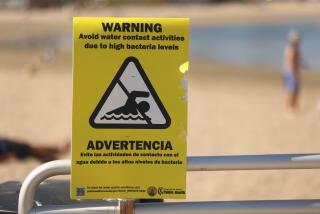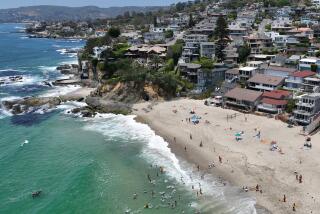Beaches have bum record on pollution
Beach closures and advisories in Los Angeles County last year fell a nose short of the record high set in 2005, according to a report issued Tuesday.
Across California there were more than 4,600 incidents of closed beaches or posted advisories in 2006, according to the review by the Natural Resources Defense Council. Of those, 2,072 were in Los Angeles County.
“Los Angeles County has the dubious distinction of having more than its fair share of polluted beaches, including the worst one -- Avalon Beach on Catalina Island,” said Michelle Mehta, an attorney with the council’s California Coastal Water Quality Program.
Beach closings and advisories also increased 5% in Orange County to 975 incidents and 32% in San Diego County to 714. The rise in San Diego County was partly due to changes in posting policy, according to the 17th annual “Testing the Waters” nationwide report. Ventura and Santa Barbara counties each showed a decrease of 61% and 56%, respectively.
Two beaches in California -- Avalon Beach and Venice State Beach in San Mateo County -- made the national Beach Bums list because bacterial levels exceeded national standards more than half the time each beach was tested. Laguna Beach in Orange County, meanwhile, won a Beach Buddy award because it violated such standards less than 10% of the time.
Trouble spots in Los Angeles County include Long Beach areas B-69 and B-70; Colorado Lagoon-South, Center and North; Santa Monica State Beach at the Pier; and Long Beach-Alamitos Bay Beach at 2nd Street Bridge and Bay Shore Avenue.
Beach closings can occur when a sewage pipe leaks or a waste water treatment plant is overwhelmed and releases untreated water. The vast majority of unhealthy conditions, though, are caused by polluted urban runoff, particularly in California, said Natural Resources Defense Council attorney David Beckman with the California Coastal Water Quality Program.
William Rukeyser, spokesman for the State Water Resources Control Board, said everything from animal droppings on the street to other bacterial sources from trash or food waste could wind up in the ocean.
“Whatever is there is going to get washed into the storm sewers and then into the ocean,” he said.
Most sewage and storm drain systems are completely separate, so nothing that goes into a storm drain is treated before it exits a pipe into the ocean. The state of California’s Clean Beaches Initiative Grant Program has awarded about $95 million for so-called dry weather diversions and other projects, Rukeyser said.
In dry weather diversion, storm sewers would be connected to sanitary sewers so that flow would be diverted to the treatment plant instead of going straight into the ocean. Since beach season corresponds with dry season, this approach is designed to protect public health.
“In an ideal world, obviously the desired objective and long-term objective is to have a year-round solution,” Rukeyser said. “Curing the wet-weather pollution of an ocean is a much more ambitious project” because storm flows during rainy season would overwhelm existing sewage treatment plants, he said.
The council suggests in the report that low-impact development should be part of the solution to beach pollution. That type of building keeps rainwater on-site so it won’t carry pollution to the ocean, Beckman said, and helps to recharge groundwater basins.
In another step toward improving the beaches, a U.S. District Court judge in Los Angeles ruled in March on a case brought by the Natural Resources Defense Council that requires the Environmental Protection Agency to upgrade its beach pollution monitoring standards. Beckman is hopeful that this will include testing that gives results in two to four hours rather than a day or two.
“Beach-goers need to know current conditions,” he said. Francine Diamond, chairwoman of the Los Angeles Regional Water Quality Control Board, said that the board supports research to find real-time indicators and to identify sources of pollution. The board has some of the highest bacterial standards in the nation and extensive monitoring requirements.
Rukeyser noted that California and its counties and municipalities spend far more money on beach protection than the federally run EPA.
Beckman said that because California does not have rainfall year-round, the problem should be more manageable than in the rest of the country -- and yet the pollution incidents continue. Diamond countered that the Los Angeles region was the “most populous and the most urban in the entire state.”
Nationally, there were more than 25,000 days of beach closings and advisories in 2006, which was more than double the amount in 2000 and 28% more than in 2005. The increase in the last year is largely due to additional polluted runoff.
But Beckman pointed out that before 2005, the number of samples increased every year because of stepped-up pollution monitoring.
“The more you look, the more you find,” he said.
More to Read
Sign up for Essential California
The most important California stories and recommendations in your inbox every morning.
You may occasionally receive promotional content from the Los Angeles Times.









